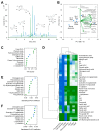Revalorization of Coffee Husk: Modeling and Optimizing the Green Sustainable Extraction of Phenolic Compounds
- PMID: 33808664
- PMCID: PMC8003551
- DOI: 10.3390/foods10030653
Revalorization of Coffee Husk: Modeling and Optimizing the Green Sustainable Extraction of Phenolic Compounds
Abstract
This study aimed to model and optimize a green sustainable extraction method of phenolic compounds from the coffee husk. Response surface methodology (RSM) and artificial neural networks (ANNs) were used to model the impact of extraction variables (temperature, time, acidity, and solid-to-liquid ratio) on the recovery of phenolic compounds. All responses were fitted to the RSM and ANN model, which revealed high estimation capabilities. The main factors affecting phenolic extraction were temperature, followed by solid-to-liquid ratio, and acidity. The optimal extraction conditions were 100 °C, 90 min, 0% citric acid, and 0.02 g coffee husk mL-1. Under these conditions, experimental values for total phenolic compounds, flavonoids, flavanols, proanthocyanidins, phenolic acids, o-diphenols, and in vitro antioxidant capacity matched with predicted ones, therefore, validating the model. The presence of chlorogenic, protocatechuic, caffeic, and gallic acids and kaemferol-3-O-galactoside was confirmed by UPLC-ESI-MS/MS. The phenolic aqueous extracts from the coffee husk could be used as sustainable food ingredients and nutraceutical products.
Keywords: antioxidant capacity; artificial neural networks; coffee by-products; phenolic compounds; response surface methodology.
Conflict of interest statement
The authors declare no conflict of interest.
Figures



 ) to the highest (
) to the highest ( ) value for each parameter) (D) showing the associations among the measured parameters and classifying phenolic extracts from coffee husk according to them, and the ten most significant coefficients from principal components regression, PCR (E) and principal least squares regression, PLS-R (F). Circles in different colors indicate minor phenolic or phenolic family, green (
) value for each parameter) (D) showing the associations among the measured parameters and classifying phenolic extracts from coffee husk according to them, and the ten most significant coefficients from principal components regression, PCR (E) and principal least squares regression, PLS-R (F). Circles in different colors indicate minor phenolic or phenolic family, green ( ), major phenolic, blue (
), major phenolic, blue ( ).
).
Similar articles
-
Response surface methodology to optimise the heat-assisted aqueous extraction of phenolic compounds from coffee parchment and their comprehensive analysis.Food Funct. 2019 Aug 1;10(8):4739-4750. doi: 10.1039/c9fo00544g. Epub 2019 Jul 16. Food Funct. 2019. PMID: 31309208
-
Optimization of ultrasonic-assisted extraction conditions for bioactive components from coffee leaves using the Taguchi design and response surface methodology.J Food Sci. 2020 Jun;85(6):1742-1751. doi: 10.1111/1750-3841.15111. Epub 2020 May 25. J Food Sci. 2020. PMID: 32449951
-
Optimization of Extraction Conditions to Improve Phenolic Content and In Vitro Antioxidant Activity in Craft Brewers' Spent Grain Using Response Surface Methodology (RSM).Foods. 2020 Oct 2;9(10):1398. doi: 10.3390/foods9101398. Foods. 2020. PMID: 33023120 Free PMC article.
-
Flavanols from green tea and phenolic acids from coffee: critical quantitative evaluation of the pharmacokinetic data in humans after consumption of single doses of beverages.Mol Nutr Food Res. 2011 Jun;55(6):864-73. doi: 10.1002/mnfr.201000631. Epub 2011 May 2. Mol Nutr Food Res. 2011. PMID: 21538847 Review.
-
Valorization of coffee pulp as bioactive food ingredient by sustainable extraction methodologies.Curr Res Food Sci. 2023 Mar 1;6:100475. doi: 10.1016/j.crfs.2023.100475. eCollection 2023. Curr Res Food Sci. 2023. PMID: 36935849 Free PMC article. Review.
Cited by
-
Combined Pulsed Electric Field and Microwave-Assisted Extraction as a Green Method for the Recovery of Antioxidant Compounds with Electroactive Potential from Coffee Agro-Waste.Plants (Basel). 2022 Sep 10;11(18):2362. doi: 10.3390/plants11182362. Plants (Basel). 2022. PMID: 36145763 Free PMC article.
-
Coffee pulp simulated digestion enhances its in vitro ability to decrease emulsification and digestion of fats, and attenuates lipid accumulation in HepG2 cell model.Curr Res Food Sci. 2024 Jul 14;9:100804. doi: 10.1016/j.crfs.2024.100804. eCollection 2024. Curr Res Food Sci. 2024. PMID: 39108698 Free PMC article.
-
Coffea arabica: An Emerging Active Ingredient in Dermato-Cosmetic Applications.Pharmaceuticals (Basel). 2025 Jan 27;18(2):171. doi: 10.3390/ph18020171. Pharmaceuticals (Basel). 2025. PMID: 40005985 Free PMC article. Review.
-
Utilisation of Exhausted Coffee Husk as Low-Cost Bio-Sorbent for Adsorption of Pb2.Trop Life Sci Res. 2022 Sep;33(3):229-252. doi: 10.21315/tlsr2022.33.3.12. Epub 2022 Sep 30. Trop Life Sci Res. 2022. PMID: 36545053 Free PMC article.
-
Chemical Analysis, Toxicity Study, and Free-Radical Scavenging and Iron-Binding Assays Involving Coffee (Coffea arabica) Extracts.Molecules. 2021 Jul 8;26(14):4169. doi: 10.3390/molecules26144169. Molecules. 2021. PMID: 34299444 Free PMC article.
References
-
- United Nations Sustainable Consumption and Production. [(accessed on 17 February 2021)]; Available online: https://www.un.org/sustainabledevelopment/sustainable-consumption-produc...
-
- FAO . Sustainable Food Systems Concept and Framework. What Is a Sustainable Food System? Why Take a Food Systems Approach? Changing Food Systems. FAO; Rome, Italy: 2018. pp. 1–8.
-
- Torres-León C., Ramírez-Guzman N., Londoño-Hernandez L., Martinez-Medina G.A., Díaz-Herrera R., Navarro-Macias V., Alvarez-Pérez O.B., Picazo B., Villarreal-Vázquez M., Ascacio-Valdes J., et al. Food Waste and Byproducts: An Opportunity to Minimize Malnutrition and Hunger in Developing Countries. Front. Sustain. Food Syst. 2018;2:52. doi: 10.3389/fsufs.2018.00052. - DOI
-
- de Sousa e Silva J., Moreli A.P., Donzeles S.M.L., Soares S.F., Vitor D.G. Food Engineering Series. Springer; Berlin/Heidelberg, Germany: 2021. Harvesting, Drying and Storage of Coffee; pp. 1–64. - DOI
Grants and funding
LinkOut - more resources
Full Text Sources
Other Literature Sources

